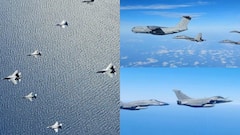Explained: What Is Chandrayaan-3? ISRO Moon Mission Aiming To Analyse The Lunar Surface
Chandrayaan-3 will be launched using the Geosynchronous Satellite Launch Vehicle Mark III (GSLV-Mk III), also called the Launch Vehicle Mark III (LVM3), from Satish Dhawan Space Centre, Sriharikota.

Chandrayaan-3: The Indian Space Research Organisation (ISRO) is set to launch Chandrayaan-3 on Friday, July 14, 2023, at 2:35 pm IST. Chandrayaan-3 is the succeeding mission to Chandrayaan-2. The primary objective of Chandrayaan-3 is to put a lander and a rover on the Moon's highlands near its south pole, and to demonstrate end-to-end landing and roving capabilities. ISRO will use Chandrayaan-2 as a backup relay. Chandrayaan-3 is expected to land on the Moon by August this year.
Chandrayaan-3 will be launched using the Geosynchronous Satellite Launch Vehicle Mark III (GSLV-Mk III), also called the Launch Vehicle Mark III (LVM3), from Satish Dhawan Space Centre, Sriharikota, Andhra Pradesh.
On July 12, 2023, the mission readiness review of Chandrayaan-3 was completed.
Chandrayaan-3: Basic facts
Consisting of a lander, a rover, and a propulsion module, Chandrayaan-3 weighs a total of 3,900 kilograms. The propulsion module, which weighs 2,148 kilograms, will carry the lander and rover to a 100-kilometre lunar orbit. The lander module, which refers to the complete configuration of the lander and the rover fitted inside the former, weighs 1,752 kilograms. The rover weighs 26 kilograms.
The rover will be similar to Chandrayaan-2's Pragyan rover, but improvements have been made to help ensure a safe landing.
The propulsion module will generate 758 Watts of power, the lander module 738 Watts, and the rover 50 Watts.
Chandrayaan-3: Objectives
The objectives of Chandrayaan-3, apart from demonstrating a safe and soft landing and roving capabilities on the lunar surface, is to conduct in-situ scientific experiments, and develop and demonstrate new technologies required for interplanetary missions, ISRO says on its website.
Chandrayaan-3: The lander, the rover, and the propulsion module
The Chandrayaan-3 lander has been designed in a way such that it can land softly in the Moon at a specified site, and deploy the rover, whose aim is to conduct in-situ chemical analysis of the lunar surface. The propulsion module will carry the lander module to the final 100-kilometre circular orbit. After reaching this orbit, the lander module and the propulsion module will separate.
The propulsion module, after separation, will remain in orbit around the Moon, and act as a communications relay satellite, NASA says on its website.
The lander, rover and propulsion modules will carry their own scientific payloads.
According to NASA, the propulsion module is a box-like structure and will be mounted with a large solar panel on one side and a large cylinder on top. The cylinder, called the Intermodule Adapter Cone, will act as a mounting structure for the lander.
At the bottom of the propulsion module, the main thruster nozzle is located.
ALSO READ | Explained: What Is Human Metapneumovirus? The Pathogen Whose Cases Saw A Recent Surge In The US
The box-shaped lander has four landing legs, four landing thrusters, a number of sensors to ensure a safe touchdown, and a suite of cameras to avoid hazards and have positional knowledge.
The lander is also equipped with an X band antenna which will ensure communications.
The rover is rectangle-shaped, and has six wheels and a navigation camera.
Chandrayaan-3: Payloads
Chandrayaan-3's lander will be equipped with five payloads. These are the Chandra's Surface Thermophysical Experiment (ChasTE), Instrument for Lunar Seismic Activity (ILSA), Langmuir Probe, Laser Retroreflector Array (LRA) Rover, and Radio Anatomy of Moon Bound Hypersensitive ionosphere and Atmosphere (RAMBHA).
ChasTE will carry out measurements of thermal properties such as thermal conductivity and temperature of elements on the lunar surface near the south pole; ILSA will measure the seismicity around the landing site and describe the structure of the lunar crust and mantle; LP will estimate plasma density; and LRA, a spacecraft from NASA, is a passive experiment which will help understand the dynamics of the Moon.
The rover is equipped with two payloads, which are the Alpha Particle X-ray Spectrometer (APXS), and Laser Induced Breakdown Spectroscope (LIBS).
ALSO READ | Spider-Man Across The Spider-Verse Review: A Multiversal Voyage With Lots To Ponder About
APXS will help determine the elemental composition of the lunar soil and rocks around the landing site. The elements to be studied include magnesium, aluminium, silicon, potassium, calcium, titanium and iron.
LIBS will conduct qualitative and quantitative elemental analysis in order to infer the chemical and mineralogical composition of the lunar surface.
The propulsion module is equipped with a payload called Spectro-polimetry of HAbitable Planet Earth (SHAPE). The function of SHAPE is to study the spectral and polarimetric measurements of Earth from lunar orbit. This means that SHAPE will analyse the spectro-polarimetric signatures of Earth.
According to the University of Maryland, Baltimore County (UMBC) Observatory, spectro-polarimetry is a technique which involves the polarisation of light by splitting the incoming light into its constituent colours, and then analysing the polarisation of each colour individually.
Understanding the spectro-polarimetric signatures of Earth can help scientists analyse the reflected light from exoplanets and determine whether they would qualify for habitability.
Chandrayaan-3: More interesting facts
The vertical velocity with which the lander will touch down on the lunar surface should be less than two metres per second, and the horizontal velocity should be less than 0.5 metre per second. The slope must be less than 120 degrees.
The mission life of Chandrayaan-3 is one lunar day, which is equivalent to about 14 Earth days.
Related Video
India@2047 Summit: Modi Calls for Innovation, Reforms, and National Resolve
Top Headlines






































